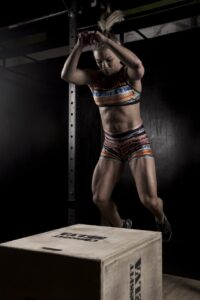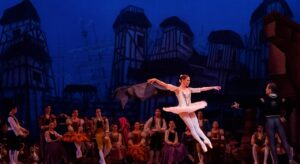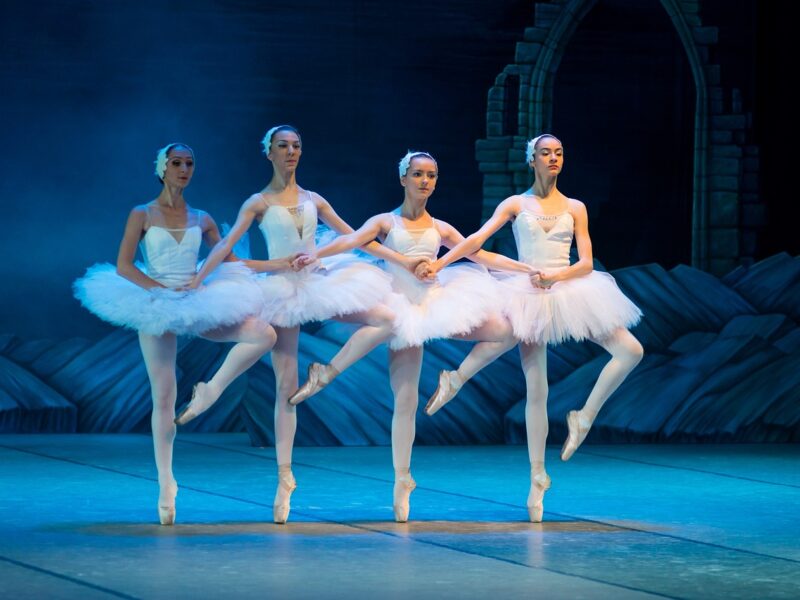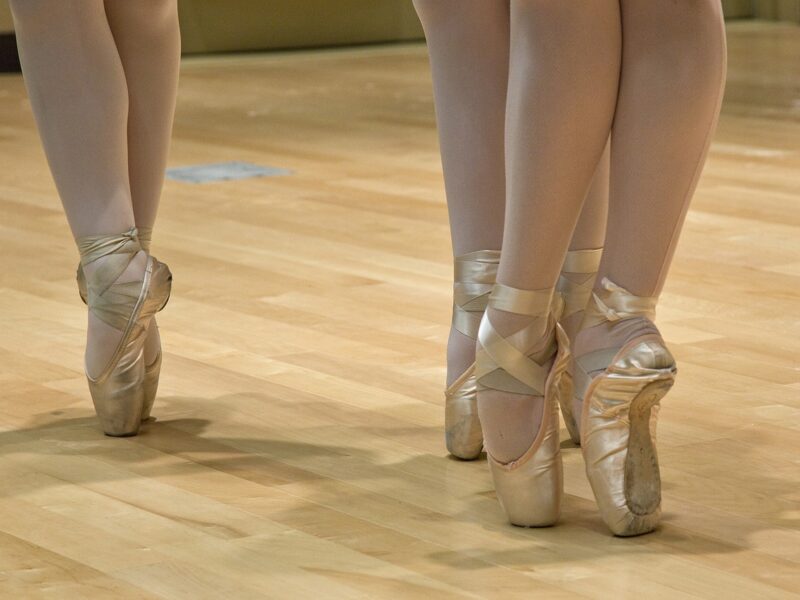I’m sure we can all agree that quick and snappy footwork is KEY to impressive petit allegro. However, making those beats happen in the blink of an eye is no easy feat, and instead requires a lot of lower body strength…
Alongside visualisation and practice, which helps us to develop muscle memory and therefore speed and precision, (head over to Part 1 of this article Achieving precision and speed in petit allegro for all the deets on this), we absolutely have to be cross training if we want our lower bodies to perform such intricate movements in the teeny time frame available for each jump!
Although jumping engages the whole body (don’t forget about keeping those arms stable and that core engaged!), in this article we are going to focus on the muscles of the lower body, which are going to help us achieve speed and precision in our footwork during petit allegro…
#1 – Quads
Let’s start with one of the most obvious… our quads! When we jump, we use our quads to push ourselves off the ground, and they also help us to straighten our legs in the air.
Science tells us that one of the most effective ways to increase the power and height of our jumps is to, well… jump!
This all has something to do with PLYOMETRICS, which is a type of exercise that involves stretching and contracting our muscles in very quick succession. This is known as the stretch-shortening cycle (SSC), and our quads follow this pattern every time we jump…
As we bend our knees in preparation to jump, our quad muscles lengthen and thus the stretch part of the cycle occurs. Following this, as we then straighten our legs to push off the ground, our quads contract from their previously stretched position, resulting in the shortening phase of the cycle.
Research shows that this type of training is great for building FAST TWITCH muscle fibres, which are the muscle fibres responsible for providing the quick bursts of power we need to push us into the air!
Although height isn’t always the goal in petit allegro (after all, petit does mean small), we do need to make sure that we are allowing ourselves enough time to get into the air and execute a clean movement, especially in batterie exercises where we need that extra millisecond to beat our legs. If we don’t jump high enough, the foot movements we execute in mid-air become rushed, causing them to look sloppy, unpolished and less impressive.
Box jumps
Box jumps are great for developing quad strength for petit allegro as they build fast twitch muscle fibres through the stretch-shortening cycle. Make sure that you are comfortable with the technique of box jumping before you try it, and always choose a low box at first if you are new to this exercise.
Step 1) With a plyo jump box placed in front of you and your feet around shoulder-width apart, rise on to your tip toes and swing your arms up above your head
Step 2) Quickly swing your arms back down to your side as you lower your heels and bend your knees (this is your preparation to jump)
Step 3) Swing your arms back above your head as straighten your legs to push off the floor into your jump
Step 4) Land on the box in a squat position with your feet slightly turned out and your arms in front of you
Step 5) Engaging your quads and glutes, stand up from your squat position

#2 – Calves
Our calves are one of the most important muscles to strengthen for petit allegro, mainly because we contract our calf muscles -whilst simultaneously extending our ankles- at the beginning of a jump to push us into the air. Our calves are also responsible for plantar flexion (the fancy word for pointing our feet) which helps our tootsies to look gorgeous and balletic in mid-air!
Single leg deficit calf raises
Step 1) Stand with the ball of your foot on a step and allow your heels to lower over the edge until you feel a stretch in your calves
Step 2) In a single count, rise up to demi pointe
Step 3) Taking 2-3 counts, slowly lower back down to the original position
In my opinion, every dancer should be doing deficit calf raises. This is because as you lower your heel off the step, your calf is stretched to its full capacity. When you then raise your heels from this fully-stretched position, you are strengthening your calf through its full range of motion.
#3 – Tibialis anterior
The tibialis anterior is a muscle located in the front of our lower leg that we use to flex our feet. It helps us to achieve rapid and precise foot movement, and it also acts as a shock absorber when we land from jumps to prevent injury.
Training the tibialis anterior allows to achieve a deeper plié which is essential for petit allegro. This is because when we plié (or bend our knees) to prepare to jump, our muscles store potential energy. As we then extend our legs and push off the floor at the beginning of our jump, this potential energy is released, giving us the power to get high into the air.
The deeper the plié, the more potential energy we store in our muscles, and therefore the higher we jump!
Dorsiflexion
Dorsiflexion is a popular exercise used to strengthen the tibialis anterior…
Step 1) Sit on the floor with your legs extended in front of you
Step 2) Place a chair beyond your feet, and tie a looped resistance band around one of the chair legs and the upper portion of your left foot (your foot should be relaxed)
Step 3) Slowly flex your foot against the resistance band, you may feel a slight contraction in your shin (this is the tibialis anterior muscle activating)
Step 4) Slowly relax your foot until you reach the starting position and then repeat
#4 – Intrinsic muscles
Our feet are made up of many teeny muscles known as the intrinsic muscles. In ballet, we often work on strengthening these to improve our arch, especially for pointe work where a stronger foot can help us to get over the platform of our shoes, providing better balance and confidence when dancing en pointe.
However, during petit allegro our intrinsic muscles are also used to stabilise the foot to improve control upon landing.
Foot doming
Step 1) Place your foot flat on the floor
Step 2) Without lifting your toes or heels, try to lift the arch of your foot off the floor (you may feel a slight contraction in the muscles underneath your arch)
Step 3) Lower the foot back to the original position and repeat
#5 – Hip flexors
Our hip flexors, which are more scientifically known as the iliopsoas, are the muscles we use to lift our leg out in front of us. Although hip flexor use in ballet is most commonly associated with développés and grand battements, we actually use our hip flexors quite a lot in petit allegro as well!
Every time we brisé, cabriole or ballonné, we are using our hip flexors to lift our leg to the front or side. It’s important that we keep our hip flexors strong and supple to help improve our technique and avoid overuse injuries!

Hip flexor marches
Step 1) Stand up straight with your feet shoulder-width apart. Tie a looped resistance band around the arches of both feet
Step 2) Slowly raise your left leg whilst bending your knee at a 90 degree angle (this should look like you are marching). You should feel some resistance from the resistance band that is wrapped around your foot
Step 3) Lower your left leg and repeat on the other side
#6 – Adductors
Our adductors are the muscles we use to bring our legs back together from an open position. We use our adductors all the time during petit allegro, for example at the end of an assemblé, or when we échappé sauté battu.
Strong adductors are essential for achieving clean and precise movements in petit allegro. If we take too long to join our legs together in mid-air, the step we are performing can look messy and unfinished. This is very true for batterie exercises, where we need to join our legs together quickly so that we can beat before the count of the music ends.
A lot of our ballet jumps always end with our feet coming together in mid-air. For example, when we assemblé, the goal is to join our feet in the air before we land, rather than bringing our feet together as we land. This means our legs must come together quickly as the jump doesn’t last forever, thus requiring strong adductors!
Copenhagen planks
Step 1) Move into a side plank position
Step 2) Place your upper leg on top of a bench around the same height as your hips
Step 3) Keeping your lower leg straight, lift it until your foot touches the underside of the bench and hold this position. Your legs and hips should look as though they are stacked on top of one another
Step 4) Repeat on the other side
Final thoughts…
Speed and precision of footwork is essential to achieve impressive petit allegro! We can improve the quality and execution of our footwork by cross training and strengthening the muscles of our lower limbs, most notably the quads, calves and tibialis anterior.
Alongside strengthening, we can work on visualisation, mental rehearsal and practice to boost the speed and precision of our petit allegro. These tools all work to improve muscle memory and increase your familiarisation of the steps in your combination!
If you want to learn more, head over to Part 1 of this article Achieving precision and speed in petit allegro, where I’ll share more of my best-kept secrets so that you too can be perfect at petit allegro… See you there!
**FRIENDLY DISCLAIMER: All information, guidance or advice provided on this site is for informational and educational purposes only. The use of this information is at your own risk. **


One thought on “Boost speed and precision in petit allegro with these exercises”
Comments are closed.